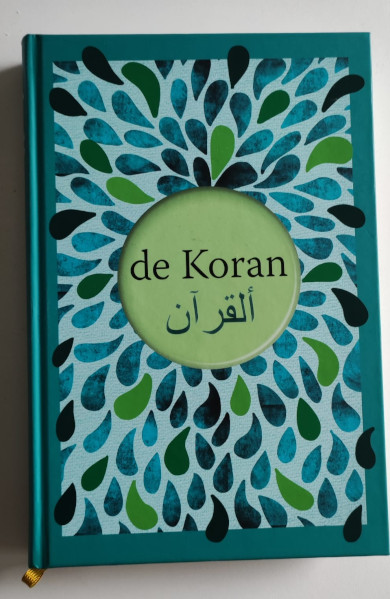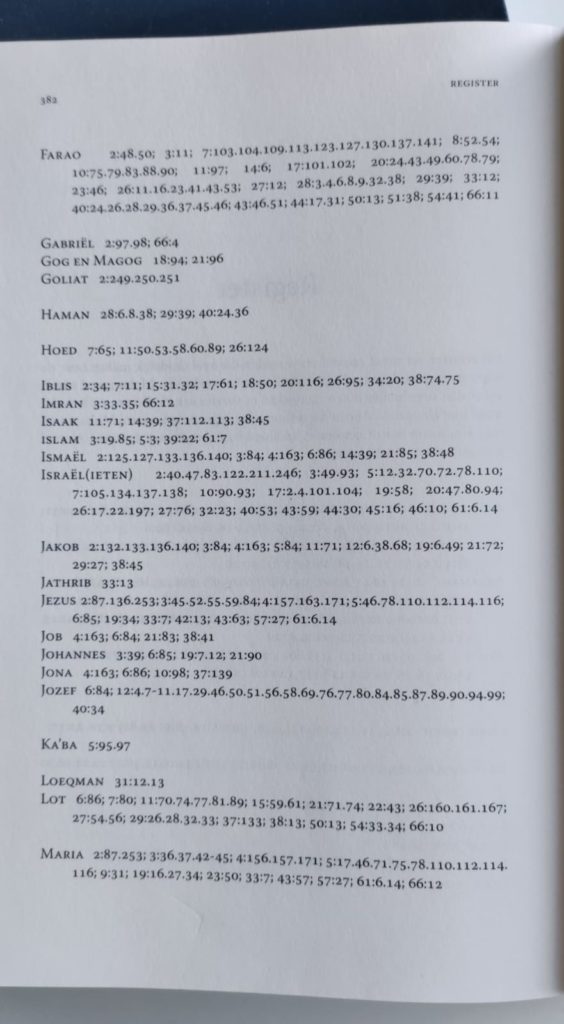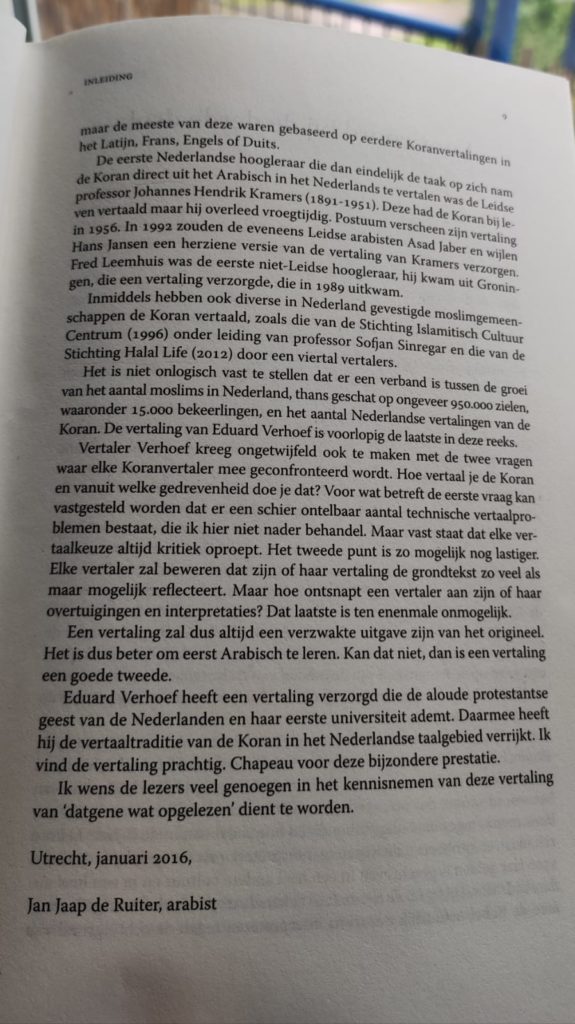‘Finally, a good translation of the Qur’an,’ declared a reviewer in ‘Volkskrant,’ a well-known newspaper in the Netherlands, on the publication of Eduard Verhoef’s translation of the Qur’an. A number of notable Dutch-speaking Muslims have likewise written positive comments on Verhoef’s translation, such as, for example, Tidjani Boulaouali, a member of the teaching staff at KU Leuven who has a PhD on Dutch Qur’an translation, and Mohammed Benzakour, a Moroccan-Dutch writer.
Verhoef received his Bachelor’s degree in theology from Vrije Universiteit Amsterdam in 1969, before starting his career as Pastor at the Reformed Church at Rotterdam-Heyplatt in the same year. He then moved to the Reformed Church of Maartensdijk in 1973, after he had finished his Masters. His academic journey continued when he embarked on his doctoral studies, in 1979 completing a dissertation on the New Testament which focused in particular on the use of Old Testament quotations in Paul’s epistle to the Galatians. He spent the next few years studying Semitic languages at the University of Amsterdam and Leiden University, while continuing his work as a pastor in Maartensdijk. His interest in languages continued and he began to study Arabic in 1993.
One might well ask what motivated Verhoef, a Christian pastor, to translate the Qur’an? When he first read the Qur’an, it was in an archaic Dutch translation, full of words and expressions that are no longer current. Once he had studied Arabic, interacting with the original Arabic himself brought him a much greater understanding of the scripture, and it seems that his decision to translate the Qur’an was inspired at least partly by his feeling that it was important to translate the Qur’an into modern Dutch so that it could be accessed by Dutch speakers. In some interviews, he has stated his belief that it is important to understand Islam because the Muslim population continues to grow in Europe, including the Netherlands, not to mention in other parts of the world. For Verhoef, the best way to understand Islam is by directly understanding its holy book, the Qur’an.
Verhoef sees many similarities between the three Semitic religious traditions of Islam, Christianity, and Judaism, and the fact that their holy books tell many similar stories about similar figures. He points out that the Qur’an contains elements that come from older traditions, in the same way as do the Torah and Bible. He also finds many theological similarities. For example, in the preface to his translation, Verhoef quotes a verse from the Qur’an, ‘This [i.e. salvation] is a true promise binding on Him in the Torah, the Gospel, and the Quran’ (Q. 9:111), to demonstrate that the concept of salvation exists in three religions.
As a pastor and student of premodern Christianity, Verhoef’s style of translation was clearly influenced by his knowledge of the Bible. In his ‘De Koran,’ therefore, he decided to use the names of the prophets and figures as they appear in the Bible, rather than in the Arabic Qur’an. In contrast to Leemhuis’ ‘Koran,’ for example, he uses Abraham rather than Ibrahim, Jezus rather than Isa, Maria instead of Maryam, Elia instead of Ilyas, Mozes for Musa, Johannes for Yahya and Michaël for Mika’il, all of which may sound unfamiliar to Muslims, although they can be easily understood by non-Muslim readers.
Verhoef finds much common ground between the Torah, Bible, and Qur’an, but asks why so much violence is committed in the name of Islam, but not in the name of the other two religions. His experience of living in the Netherlands, where the growing number of Muslim migrants has been accompanied by a few cases of violence conducted by Muslims in the name of Islam has, I believe, influenced this interest. He has, over time, become more and more interested in investigating and comparing Christianity and Islam, especially on the question of what makes Christianity or Islam unique when so much of both of these religions have been adopted from older traditions. The result of this interest is his publication, ‘Jezus in christendom en islam’ (‘Jesus in Christianity and Islam’, Skandalon, 2021), in which he discusses in detail how Jesus was discussed in the Bible and in Qur’an.
He started out on his translation of the Qur’an in 2007, and it was published in early 2015. A completely revised second edition came out in January 2016, and the third, corrected, edition was published in 2019 by Skandalon, a Dutch Christian publisher that focuses on religious studies and works relating to the different religious traditions, such as the Christian Bible, the Qur’an and the Bhagavad Gita.
Verhoef’s translation of the Qur’an includes an introduction by the Dutch Arabist Jan Jaap de Ruiter. Ruiter explains a little bit about the background against which the Qur’an was revealed, in addition to providing a brief history of Qur’an translation into Dutch. The translation itself does not contain Arabic parallel text, as many other recent translations of the Qur’an do. With the exception of the introduction, it contains no other paratextual material at all: there are no (foot)notes, or discussions on the history of the text, the complexity of the Arabic language, or the peculiarities of its classical expression, and, as a consequence, the translation seems somehow lacking.
In the “Verantwording” page of ‘De Koran,’ Verhoef admits that ‘In a translation, elements are always lost. A literal Dutch translation is not available for every Arabic word.’ I quote in full: ‘The book reflects my vision and my interpretation and is, in any case, a well-intentioned attempt to interpret things. Sometimes the explanation is irrefutable because it is related to an event in a particular time and place. When it comes to other matters I have mostly stuck to the so-called traditional opinions. I have not done this because I would always like to defend them, but because scientific research is not yet very advanced, and I cannot base myself on it.’ Once the translation of the first edition had been published, Verhoef was so frequently asked about the background to the Qur’an’s various stories, as well as about names and difficult verses, that he felt the need to write ‘Uitleg bij de Koran,’ or ‘An Explanation of the Quran,’which was published in 2017, a year after the second edition of ‘De Koran’ emerged.
Verhoef mentions the names of various other Dutch translators of the Qur’an as his references, including G. Leemhuis, A.Wessels, F. Okumus and Karel Steenbrink. He also refers to Rudi Paret as a German source, and M.A.S Abdel Haleem’s English Qur’an translation. Regardless of his motivation for translating the Qur’an, whether this be apologetic or due to academic curiosity, his preference for Q 9:111 over all the thousands of other verses indicates his desire to invite everyone to enter into dialogue with Islam through the text of the Qur’an.
Yulianingsih Riswan



